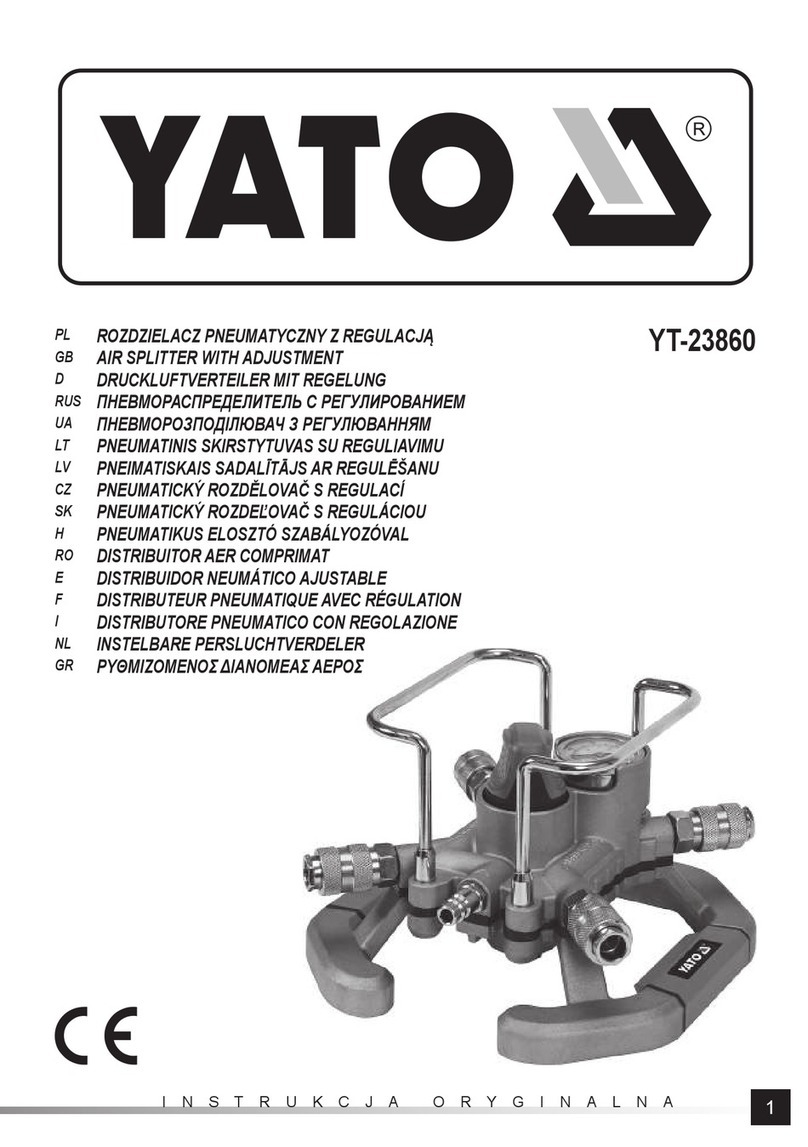
INSTRUKCJA ORYGINALNA
6
PL
Zagrożenia związane z wyrzucanymi częściami
Odłączyć narzędzie od źródła zasilania przed wymianą narzędzia wstawionego lub akcesoria. Uszkodzenie obrabianego przed-
miotu, akcesoriów lub nawet narzędzia wstawianego może spowodować wyrzucenie części z dużą prędkością. Zawsze należy
stosować ochronę oczu odporną na uderzenia. Stopień ochrony należy dobierać w zależności od wykonywanej pracy. Należy
się upewnić, ze obrabiany przedmiot jest bezpiecznie zamocowany. W przypadku pracy narzędziem nad głową, stosować hełm
ochronny. Należy również brać pod uwagę ryzyko wobec osób postronnych. Należy się upewnić, ze obrabiany przedmiot jest
bezpiecznie zamocowany. Nie pracować narzędziem bez upewnienia się, że został zainstalowany ogranicznik narzędzia wstawia-
nego. Aby uniknąć obrażeń, należy wymieniać ogranicznik kiedy zostanie zużyty, pęknięty lub zniekształcony. Pewnie przyłożyć
narzędzie wstawiane do obrabianej powierzchni przed rozpoczęciem pracy.
Zagrożenia związane z pracą
Użytkowanie narzędzia może wystawić ręce operatora na zagrożenia, takie jak: zmiażdżenie, uderzenie, odcięcie, ścieranie oraz
gorąco. Należy ubierać właściwe rękawice do ochrony rąk. Operator oraz personel konserwujący powinni być fi zycznie zdolni do
poradzenia sobie z ilością, masą oraz mocą narzędzia. Trzymać narzędzie poprawnie. Zachować równowagę oraz zapewniające
bezpieczeństwo ustawienie stóp. Należy zwolnić nacisk na urządzenie startu i stopu w przypadku przerwy w dostawie energii
zasilającej. Używać tylko środków smarnych zalecanych przez producenta. Unikać bezpośredniego kontaktu z narzędziem wsta-
wianym podczas oraz po pracy, może być gorące. Należy stosować okulary ochronne, zalecane jest stosowanie dopasowanych
rękawic oraz stroju ochronnego.
Zagrożenia związane z powtarzalnymi ruchami
Podczas stosowania narzędzia pneumatycznego do pracy polegającej na powtarzaniu ruchów, operator jest narażony na do-
świadczenie dyskomfortu dłoni, ramion, barków, szyi lub innych części ciała. W przypadku użytkowania narzędzia pneumatycz-
nego, operator powinien przyjąć komfortową postawę zapewniającą właściwe ustawienie stóp oraz unikać dziwnych lub nie
zapewniających równowagi postaw. Operator powinien zmieniać postawę podczas długiej pracy, pomoże to uniknąć dyskomfortu
oraz zmęczenia. Jeżeli operator doświadcza symptomów takich jak: trwały lub powtarzający się dyskomfort, ból, pulsujący ból,
mrowienie, drętwienie, pieczenie lub sztywność. Nie powinien ich ignorować, powinien powiedzieć o tym pracodawcy i skonsul-
tować się z lekarzem.
Zagrożenia związane z akcesoriami
Odłączyć narzędzie od źródła zasilania przed zmianą narzędzia wstawionego lub akcesoria. Stosować akcesoria i materiały eks-
ploatacyjne tylko w rozmiarach i typach, które są zalecane przez producenta. W przypadku młotków, w stosownych przypadkach,
nigdy nie używać jakichkolwiek dłut jako narzędzi ręcznych. Zostały one specjalnie zaprojektowane i poddane obróbce cieplnej
pod kątem wykorzystania jedynie w nieobrotowych narzędziach udarowych. W przypadku młotków i kruszarek, w stosownych
przypadkach, nigdy nie używać tępych dłut, ponieważ są one poddawane dużemu obciążeniu i może pęknąć ze względu zmę-
czenia materiału. Użycie tępego narzędzia może zwiększyć wibracje i dlatego zawsze powinno się stosować naostrzone narzę-
dzia. W przypadku młotków, w stosownych przypadkach, nigdy nie chłodzić gorących narzędzi wstawianych w wodzie, może to
skutkować kruchością i przedwczesnym zużyciem. W przypadku młotków, w stosownych przypadkach, uszkodzenie lub pękniecie
narzędzia może wynikać z niewłaściwego wykorzystania narzędzia jako dźwigni, np. przy podważaniu. Lepiej pracować, usuwa-
jąc mniejsze fragmenty, co pozwoli uniknąć zacięć. Unikać bezpośredniego kontaktu z narzędziem wstawianym podczas oraz po
pracy, może być gorące lub ostre.
Zagrożenia związane z miejscem pracy
Poślizgnięcia, potknięcia i upadki są głównymi przyczynami obrażeń. Wystrzegać się, śliskich powierzchni spowodowanych użyt-
kowaniem narzędzia, a także zagrożeń potknięciem spowodowanym instalacją powietrzną. Postępować ostrożnie w nieznanym
otoczeniu. Mogą istnieć ukryte zagrożenia, takie jak elektryczność lub inne linii użytkowe. Narzędzie pneumatyczne nie jest
przeznaczone do stosowania w strefach zagrożonych wybuchem i nie jest izolowane od kontaktu z energią elektryczną. Upewnić
się, że nie istnieją żadne przewody elektryczne, rury gazowe, itp., które mogą powodować zagrożenie w przypadku uszkodzenia
przy użyciu narzędzia.
Zagrożenia związane z oparami i pyłami
Pył i opary powstałe przy użyciu narzędzia pneumatycznego mogą spowodować zły stan zdrowia (na przykład raka, wady wrodzo-
ne, astma i/ lub zapalenie skóry), niezbędne są: ocena ryzyka i wdrożenie odpowiednich środków kontroli w odniesieniu do tych
zagrożeń. Ocena ryzyka powinna zawierać wpływ pyłu utworzonego przy użyciu narzędzia i możliwość wzburzenia istniejącego
pyłu. Wylot powietrza należy tak kierować, aby zminimalizować wzbudzanie pyłu w zakurzonym środowisku. Tam gdzie powstają
pył lub opary, priorytetem powinna być kontrola ich w źródle emisji. Wszystkie zintegrowane funkcje i wyposażenie do zbierania,
ekstrakcji lub zmniejszenia pyłu lub dymu powinny być prawidłowo użytkowane i utrzymywane zgodnie z zaleceniami producenta.
Używać ochrony dróg oddechowych, zgodnie z instrukcjami pracodawcy oraz zgodnie z wymogami higieny i bezpieczeństwa.
Obsługę i konserwację narzędzia pneumatycznego należy przeprowadzać według zaleceń instrukcji obsługi, pozwoli zminimali-
zować emisję oparów i pyłu. Wybierać, konserwować i wymieniać narzędzia wstawiane według zaleceń instrukcji, aby zapobiec
wzrostowi oparów i pyłu.




























